Double-End Location Technology of Partial Discharge in Cables Based on Frequency-Domain Reflectometry
Abstract
1. Introduction
2. Principle of Partial Discharge Double-End Location via Frequency-Domain Reflectometry
2.1. Basic Principles
2.2. Cable Transfer Function Acquisition Method Based on Partial Discharge Signals
- Take the maximum value of the frequency-domain expression, , of the partial discharge signal obtained at the first end of the cable and record its corresponding frequency.
- Take the two frequency points corresponding to 5% of the maximum value of as the effective frequency band range of the first-end partial discharge signal. The two frequency points are located to the left and right of the maximum frequency point, respectively, and ensure that the effective frequency band is minimized.
- Take the maximum value of the frequency-domain expression, , of the partial discharge signal obtained at the last end of the cable and record its corresponding frequency.
- Take the two frequency points corresponding to 5% of the maximum value of as the effective frequency band range of the second-end partial discharge signal. The two frequency points are located to the left and right of the maximum frequency point, respectively, and ensure that the effective frequency band is minimized.
- Take the intersection of the effective frequency bands of the first and second partial discharge signals as the effective frequency band of the cable transfer function.
2.3. Location Method Based on Frequency-Domain Reflectometry
- Take the maximum value of the cable partial discharge location function as the initial location result of the partial discharge.
- Input the initial location result into the region determination function.
- If the value of the region determination function is positive, it is determined that the partial discharge signal originates from the inside of the monitored cable. The location of the partial discharge can be obtained by combining the total length of the cable, , and the initial location result, .
- If the value of the region determination function is negative, it is determined that the partial discharge signal originates from the outside of the monitored cable. The initial location result is the distance between the two high-frequency current sensors.
3. Simulation
3.1. Partial Discharge Inside the Cable
3.2. Partial Discharge Outside the Cable
4. Experiment
5. Conclusions
- In order to ensure the reliability of the cable transfer function obtained by using the partial discharge signals measured at both ends of the cable, the frequency band modulation technique is proposed. The frequency band modulation technique obtains the effective frequency band range of the transfer function according to the frequency band range of the partial discharge signals measured at both ends of the cable, which ensures the reliability of the transfer function.
- In order to achieve the region determination and obtain the accurate location of the partial discharge in a cable, the partial discharge location method based on frequency-domain reflectometry is proposed. The partial discharge location method constructs the cable partial discharge location function and the region determination function through a spectral analysis of the cable transfer function. Using the partial discharge location function peaks and region determination function symbol, one can effectively determine whether the partial discharge exists inside the cable and locate it accurately.
- The simulation and experiment show that the cable partial discharge double-end location technology based on frequency-domain reflectometry proposed in this paper can effectively overcome the shortcomings of the traditional partial discharge location algorithm due to the dispersion and attenuation effect resulting in a large location deviation, and it can also realize the region determination and accurate location of the discharge defect.
Author Contributions
Funding
Institutional Review Board Statement
Informed Consent Statement
Data Availability Statement
Conflicts of Interest
References
- Zhou, C.; Yi, H.; Dong, X. Review of recent research towards power cable life cycle management. High Volt. 2017, 2, 179–187. [Google Scholar] [CrossRef]
- Nadolny, Z. Electric field distribution and dielectric losses in XLPE insulation and semiconductor screens of high-voltage cables. Energies 2022, 15, 4692. [Google Scholar] [CrossRef]
- Zhou, K.; Tang, Z.; Meng, P.; Huang, J.; Xu, Y.; Rao, X. A novel method for sign judgment of defects based on phase correction in power cable. IEEE Trans. Instrum. Meas. 2023, 73, 1–9. [Google Scholar] [CrossRef]
- Shadi, M.R.; Mirshekali, H.; Shaker, H.R. Partial Discharge-Based Cable Vulnerability Ranking with Fuzzy and FAHP Models: Application in a Danish Distribution Network. Sensors 2025, 25, 3454. [Google Scholar] [CrossRef]
- Bakhshizadeh, M.K.; Vilmann, B.; Kocewiak, Ł. Modal aggregation technique to check the accuracy of the model reduction of array cable systems in offshore wind farms. Energies 2022, 15, 7996. [Google Scholar] [CrossRef]
- Zhang, W.; Song, Y.; Wu, X.; Liu, H.; Tian, H.; Tang, Z.; Xu, S.; Chen, W. Detecting Partial Discharge in Cable Joints Based on Implanting Optical Fiber Using MZ–Sagnac Interferometry. Sensors 2025, 25, 3166. [Google Scholar] [CrossRef]
- Montanari, G.C. Partial discharge detection in medium voltage and high voltage cables: Maximum distance for detection, length of cable, and some answers. IEEE Electr. Insul. Mag. 2016, 32, 41–46. [Google Scholar] [CrossRef]
- Li, Y.; Han, J.; Du, Y.; Jin, H. Time-frequency maps for multiple partial discharge sources separation in cable terminations. IEEE Trans. Power Deliv. 2023, 38, 2228–2231. [Google Scholar] [CrossRef]
- Gouda, O.E.; ElFarskoury, A.A.; Elsinnary, A.R.; Farag, A.A. Investigating the effect of cavity size within medium-voltage power cable on partial discharge behaviour. IET Gener. Transm. Distrib. 2018, 12, 1190–1197. [Google Scholar] [CrossRef]
- Qin, C.; Zhu, X.; Zhu, P.; Lin, W.; Liu, L.; Che, C.; Liang, H.; Hua, H. Partial Discharge Signal Pattern Recognition of Composite Insulation Defects in Cross-Linked Polyethylene Cables. Sensors 2024, 24, 3460. [Google Scholar] [CrossRef]
- Liu, H.; Li, H.; He, N.; Teng, J.; Cao, B.; Miao, W.; Bai, R.; Li, X.; Gao, C. Design of an Ultra-High-Frequency Through-Core Current Transformer for Cable Partial Discharge Detection. Electronics 2025, 14, 2547. [Google Scholar] [CrossRef]
- Kreuger, F.; Wezelenburg, M.; Wiemer, A.; Sonneveld, W. Partial discharge. XVIII. Errors in the location of partial discharges in high voltage solid dielectric cables. IEEE Electr. Insul. Mag. 2002, 9, 15–22. [Google Scholar] [CrossRef]
- Gao, S.; Liu, H.; Fan, H. PD location method of power cable based on wavelet transform modulus maxima considering wave characteristics. Power Syst. Technol. 2016, 40, 2244–2250. [Google Scholar]
- Shu, E.W.; Boggs, S. Dispersion and PD detection in shielded power cable. IEEE Electr. Insul. Mag. 2008, 24, 25–29. [Google Scholar] [CrossRef]
- Ju, T.; Jiao, C.; Xiaoxing, Z. Time difference algorithm based on energy relevant search of multi-sample applied in PD location. Proc. CSEE 2009, 29, 125–130. [Google Scholar]
- Wagenaars, P.; Wouters, P.; Van Der Wielen, P.; Steennis, E. Accurate estimation of the time-of-arrival of partial discharge pulses in cable systems in service. IEEE Trans. Dielectr. Electr. Insul. 2008, 15, 1190–1199. [Google Scholar] [CrossRef]
- Liu, J.; Tang, J.; Lang, Y. Approach for timedelay location of UHF signals of GIS partial discharge based on interpolating cross-correlation function. Gaoya Dianqi/High Volt. Appar. 2018, 54, 62–67. [Google Scholar]
- Liu, W.; Liu, S.; Hu, X.; Wei, M.; Zhang, Y.; Fan, G. Aperiodic weak partial discharge source detection based on accumulation of cross correlation estimation information. High Volt. Eng 2017, 43, 966–972. [Google Scholar]
- Kai, Z.; Xianjie, R.; Xianjin, W. Application of distance based cross-correlation algorithm in partial discharge location of power cables. High Volt. Technol. 2021, 47, 2946–2954. [Google Scholar]
- Min, X.; Kai, Z.; Shilin, Z. Research on partial discharge location using modified crosscorrelation method considering frequency characteristic of phase velocity. Power Syst. Technol. 2018, 42, 1661–1667. [Google Scholar]
- Mardiana, R.; Su, C.Q. Partial discharge location in power cables using a phase difference method. IEEE Trans. Dielectr. Electr. Insul. 2010, 17, 1738–1746. [Google Scholar] [CrossRef]
- Huangxi, C.; Chunhua, F.; Ziheng, P. Double-ended positioning of partial discharge for long cable based on VMD-WVD phase method. Electr. Power Eng. Technol. 2022, 41, 171–177. [Google Scholar]
- Ghorat, M.; Gharehpetian, G.B.; Latifi, H.; Hejazi, M.A. A new partial discharge signal denoising algorithm based on adaptive dual-tree complex wavelet transform. IEEE Trans. Instrum. Meas. 2018, 67, 2262–2272. [Google Scholar] [CrossRef]
- Govindarajan, S.; Subbaiah, J.; Cavallini, A.; Krithivasan, K.; Jayakumar, J. Partial discharge random noise removal using Hankel matrix-based fast singular value decomposition. IEEE Trans. Instrum. Meas. 2019, 69, 4093–4102. [Google Scholar] [CrossRef]
- Wang, X.; Wang, X.; Gao, J.; Tian, Y.; Kang, Q.; Zhang, F.; Liu, W. A denoising method for cable partial discharge signals based on image information entropy and multivariate variational mode decomposition. IEEE Trans. Instrum. Meas. 2023, 73, 3500415. [Google Scholar] [CrossRef]
- Tang, J.; Zhou, S.; Pan, C. A denoising algorithm for partial discharge measurement based on the combination of wavelet threshold and total variation theory. IEEE Trans. Instrum. Meas. 2019, 69, 3428–3441. [Google Scholar] [CrossRef]




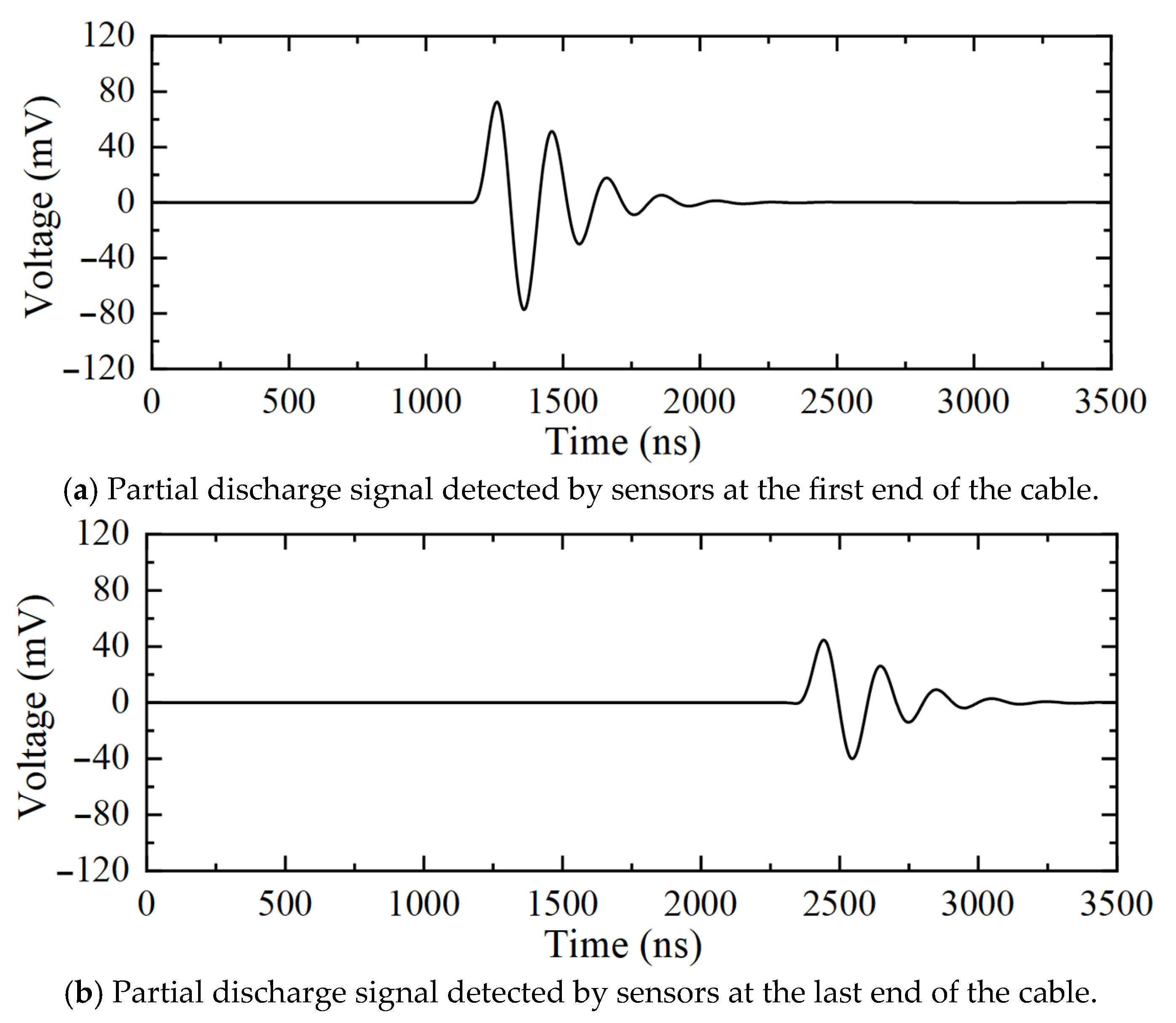
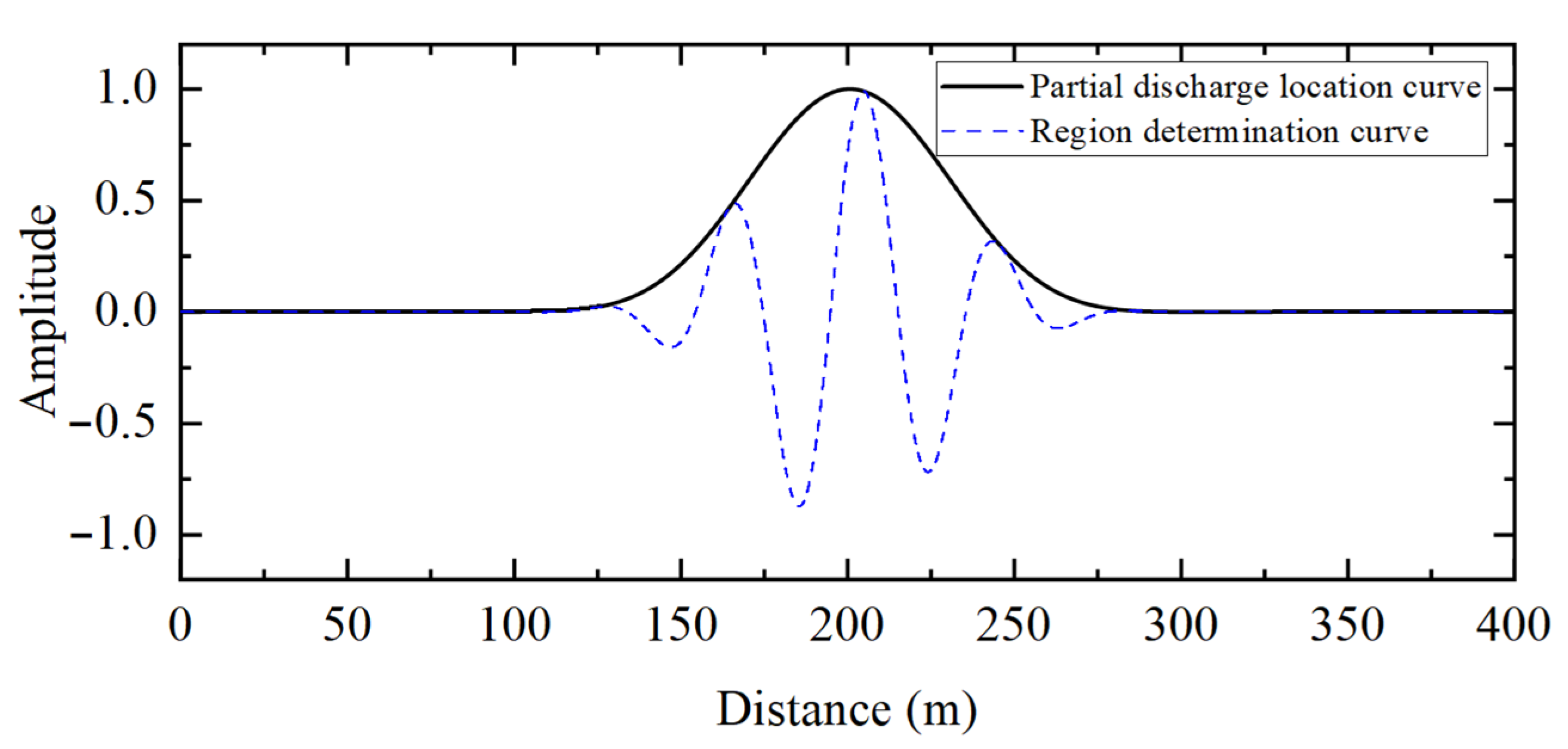

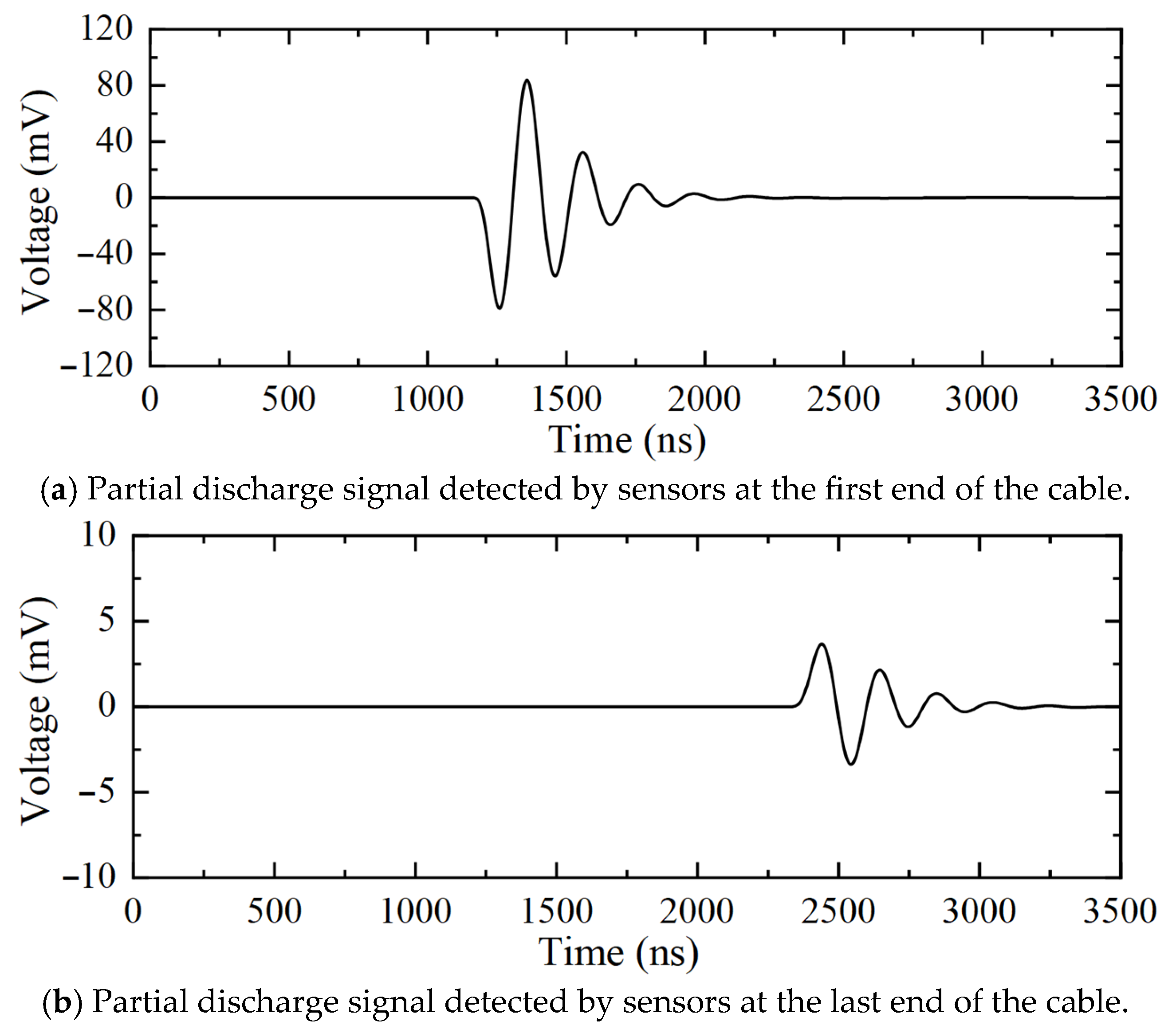
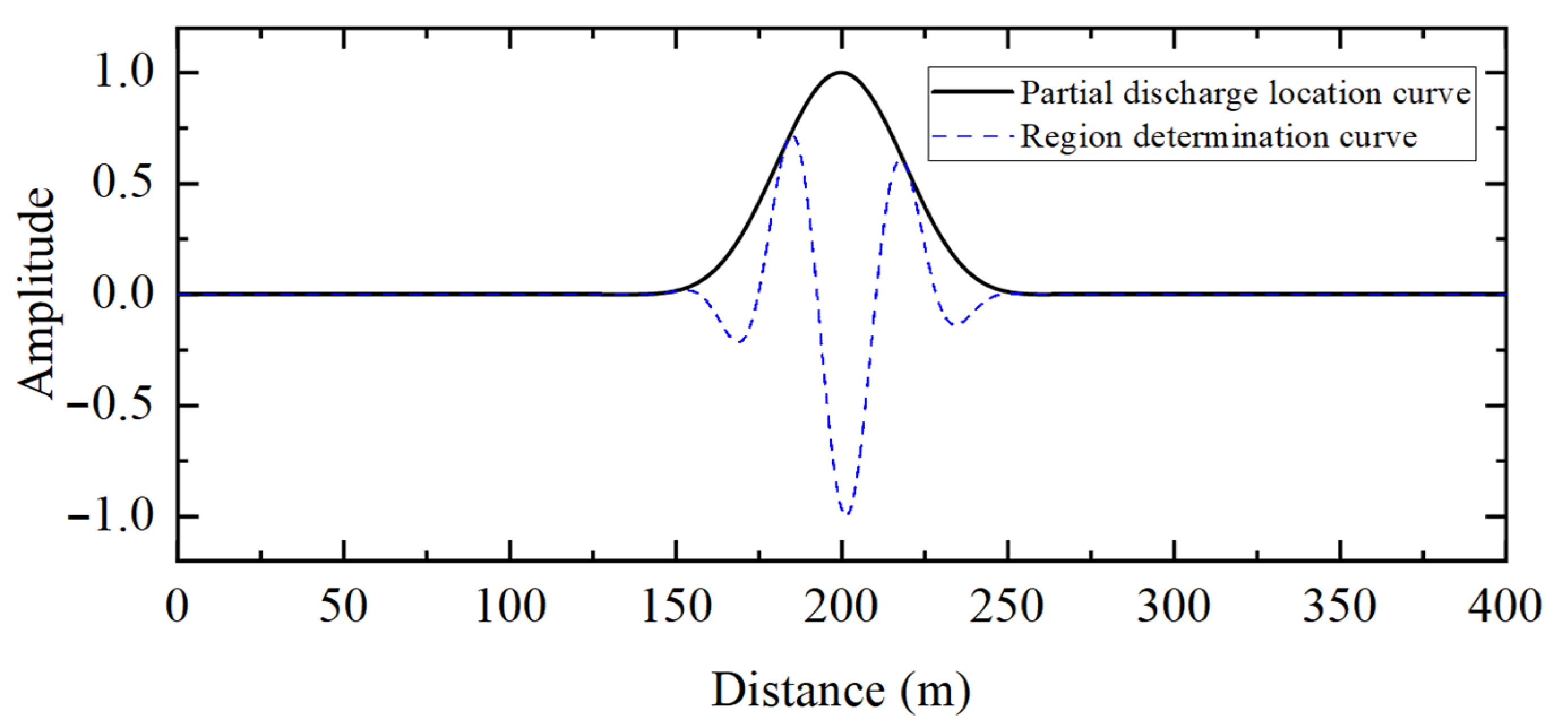

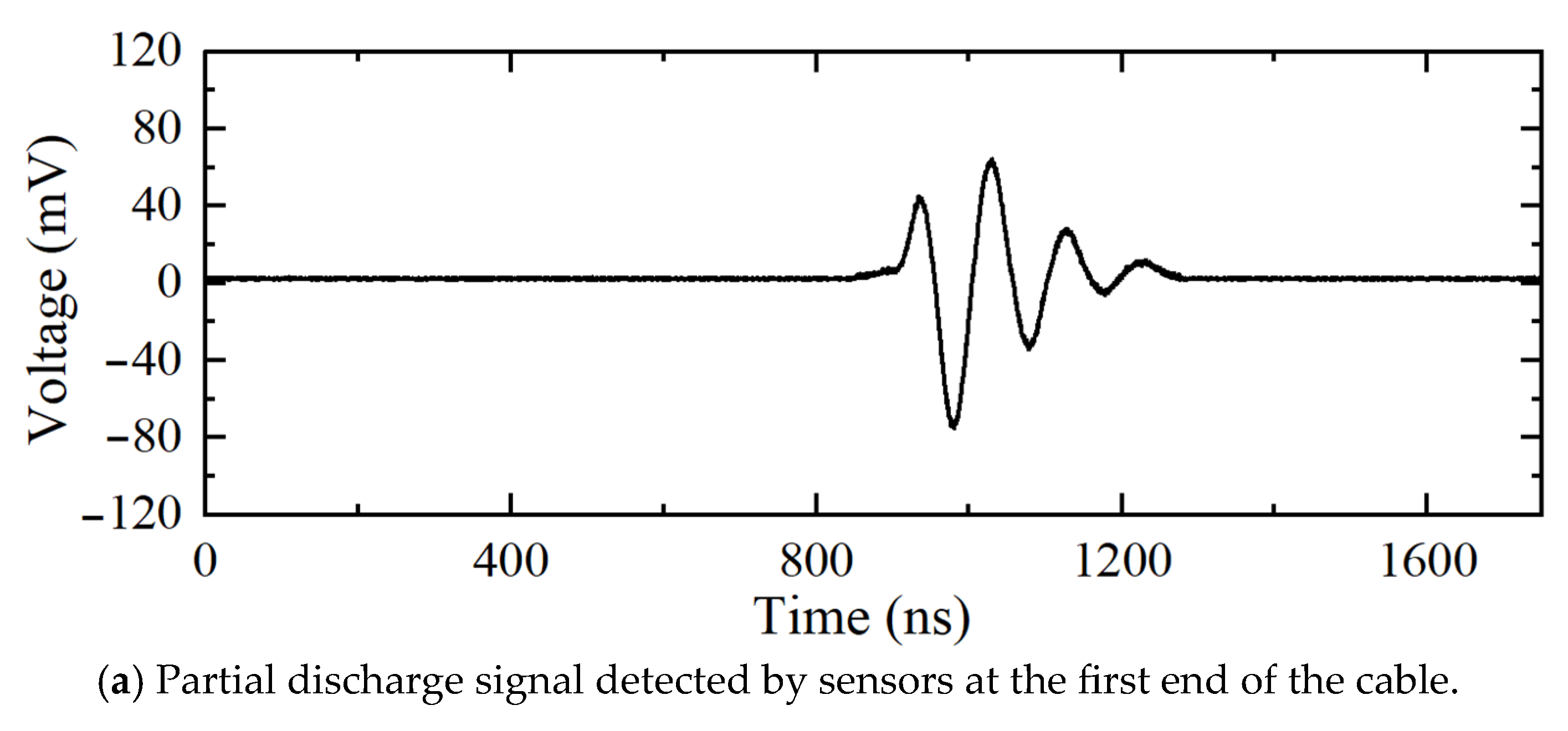
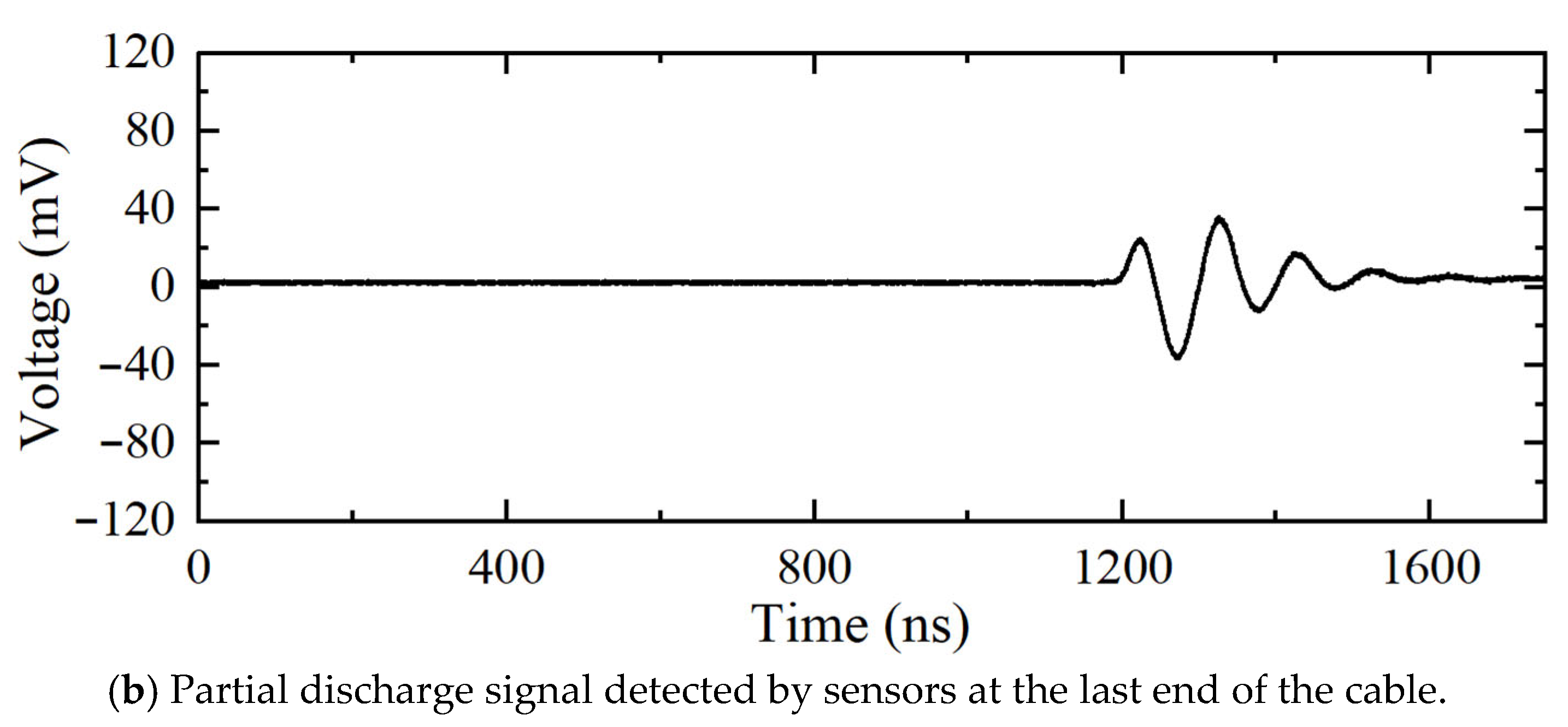

| Type | Title | Value |
|---|---|---|
| Structural parameters | Inner conductor radius (mm) | 3.51 |
| Conductor shield thickness (mm) | 0.38 | |
| XLPE insulation thickness (mm) | 5.04 | |
| Insulation shield thickness (mm) | 0.38 | |
| Outer conductor shield radius (mm) | 9.31 | |
| Electrical parameters | Inner conductor conductivity (S/m) | 5.71 × 107 |
| Outer conductor conductivity (S/m) | 5.71 × 107 | |
| XLPE insulation relative dielectric constant | 2.3 | |
| Relative permeability | 1 |
Disclaimer/Publisher’s Note: The statements, opinions and data contained in all publications are solely those of the individual author(s) and contributor(s) and not of MDPI and/or the editor(s). MDPI and/or the editor(s) disclaim responsibility for any injury to people or property resulting from any ideas, methods, instructions or products referred to in the content. |
© 2025 by the authors. Licensee MDPI, Basel, Switzerland. This article is an open access article distributed under the terms and conditions of the Creative Commons Attribution (CC BY) license (https://creativecommons.org/licenses/by/4.0/).
Share and Cite
Miao, W.; Liu, H.; Song, C.; Li, H.; He, N.; Teng, J.; Cao, B.; Bai, R.; Li, X.; Mu, H. Double-End Location Technology of Partial Discharge in Cables Based on Frequency-Domain Reflectometry. Sensors 2025, 25, 4710. https://doi.org/10.3390/s25154710
Miao W, Liu H, Song C, Li H, He N, Teng J, Cao B, Bai R, Li X, Mu H. Double-End Location Technology of Partial Discharge in Cables Based on Frequency-Domain Reflectometry. Sensors. 2025; 25(15):4710. https://doi.org/10.3390/s25154710
Chicago/Turabian StyleMiao, Wang, Hongjing Liu, Ci Song, Hongda Li, Nan He, Jingzhu Teng, Baoqin Cao, Ruonan Bai, Xianglong Li, and Haibao Mu. 2025. "Double-End Location Technology of Partial Discharge in Cables Based on Frequency-Domain Reflectometry" Sensors 25, no. 15: 4710. https://doi.org/10.3390/s25154710
APA StyleMiao, W., Liu, H., Song, C., Li, H., He, N., Teng, J., Cao, B., Bai, R., Li, X., & Mu, H. (2025). Double-End Location Technology of Partial Discharge in Cables Based on Frequency-Domain Reflectometry. Sensors, 25(15), 4710. https://doi.org/10.3390/s25154710





